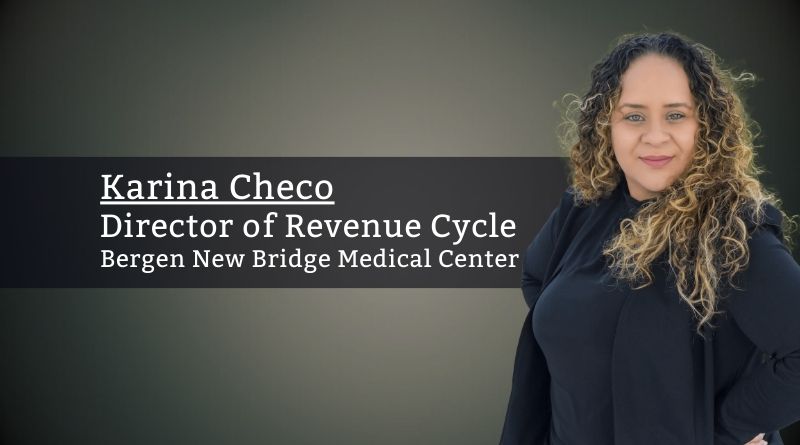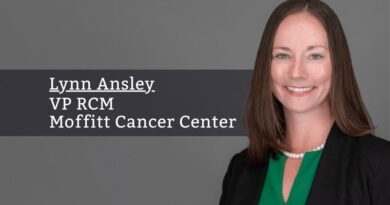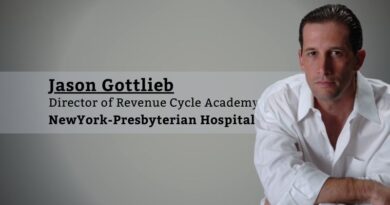Strategic Approach to Revenue Cycle Management (RCM)
By Karina Checo, Director of Revenue Cycle, Bergen New Bridge Medical Center
The revenue cycle sector of healthcare has seen a dramatic evolution in roles over the last decade. Daily tasks have changed to accommodate regulatory, technological, and payer behavior changes. To stay ahead of this ever-changing landscape, we have had to shift our perspective and approach toward operational strategies.
This change begins with a transformative leadership style. A successful revenue cycle leader must also be an effective change manager. Being a transformative leader requires early diagnosis of issues facing the revenue cycle and the development of an action plan to mitigate any negative impacts on revenue, cash flow, and most importantly, patient care. In this new era, there are many tools in the healthcare revenue cycle to help create an effective action plan. As we develop improved revenue cycle strategies we face difficult decisions on when and how to utilize these tools and partnerships. From artificial intelligence (AI) and machine learning (ML), to savvy employees, the revenue cycle team must lean into the benefits of all these and develop a strategy that suits their organization.
So, where do we start?
You start by identifying your problem which is often a change that directly affects reimbursement. Early detection of a problem is criticla to effective revenue cycle leadership. Leaders must take a deep dive into their organization’s key performance indicators (KPIs) and variance reports to understand typical operational numbers. This makes it easier to identify areas of potential improvement and detect drastic changes. My revenue cycle teams work closely with our strategy and analytics departments to ensure continuous process improvement in our reporting. An emphasis on validation and auditing is essential to develop reliable performance reports and dashboards. These are the high-level pulse checks necessary to manage the revenue cycle while adapting to the changes in the landscape. Sometimes the problem is not buried in the data, however. Being aware of the problem also means staying informed of regulatory changes and developing a proactive action plan to mitigate risk and exposure. For example, the No Surprises Actimposed operational and technical changes for front-end revenue cycle teams. Early action on managing this change yielded better compliance outcomes.
Despite the rapid technological advances in the healthcare revenue cycle, a sophisticated and specialized human touch is still required.
Ok, so we know the problem. How do we solve it?
A mentor once told me, “Anything is possible if you use the right tool for the job.” Selecting the right tool is a dilemma often faced in the RCM landscape. The industry is overwhelmed with various tools and technology available to solve problems in all areas of the cycle. This, combined with the high dependency on human resources, is a difficult decision to make. Selecting the correct tool for the job looks different for each organization and its leaders. It is important to know your team’s strengths and the opportunities available to them. How much time will it take to correct the issue and implement the corrective action plan? Ask yourself the key questions, can we automate this workflow? If so, what is the acceptable margin of error? Automation has been a key element in the evolution and modernization of revenue cycle operations over the past ten years. It has drastically improved the efficiency of the revenue cycle workflows, but requires consistent monitoring and auditing to ensure it works. Aside from having the traditional denial management teams/committees to detect issues, variance reporting and reconciliation are equally important to the set-up of the automated workflows. Insurance discovery, authorization requests, claim submission, and payment posting are examples of some revenue cycle functions that are often automated. These functions must still be monitored and reconciled regularly. A specialized RCM team is imperative for this workflow to be successful.
Need help?
Another valuable tool to fix a problem is forming strategic partnerships which means hiring someone who can fix it. As a revenue cycle leader, it is important to distinguish between the issues that require your time and expertise and those more effectively managed by a subject matter expert (SME). Strategic partnerships are critical to addressing niche areas of expertise, like software development, customer service, accounts receivables follow-up, and analytics, to name a few. Too often, managers invest too much time and resources for an insignificant return on their investment. Also, most providers do not have abundant resources to manage the workload. In such situations, the opportunity cost of allocating resources to some projects is too high and outsourcing is the best solution. Knowing what you do well is important, as is consulting with an expert for other areas of opportunity.
Despite the rapid technological advances in the healthcare revenue cycle, a sophisticated and specialized human touch is still required. Revenue cycle teams have evolved and require more critical thinking and analysis than they did years ago. RCM leaders must pivot their leadership styles to optimize operational efficiency and maximize reimbursements. The complexity of the claim appeals process and claim escalations with payers requires a specialized, trained revenue cycle team. The biller position has now evolved to a more sophisticated role, and will continue to evolve as the revenue cycle becomes more complex. Also, it is more that our patients are also consumers and have many alternatives when accessing healthcare. Providers must consider this and implement strategies that focus on improving the patient experience throughout the revenue cycle. We strive to remove the barriers to healthcare by expanding access and eliminating financial barriers. As we lean into modern technology to help automate and create efficient workflows, we can dedicate more time to creating more patient-centric revenue cycle workflows.



